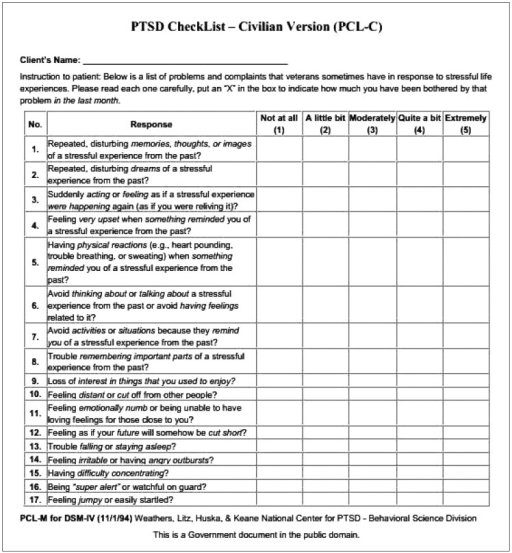Please circle one number, 0-3. Respondents are asked to rate how often they have experienced each symptom in the last two months using a 4-point frequency rating scale ranging from (never) to (often). TSCC mäter ett brett spektrum av traumatiska symptom och lämpar sig framförallt för screening men kan också användas för att utvärdera effekter av psykoterapeutiska interventioner.
TSCC består av påståenden som ger resultat på: Två validitetsskalor Undersvar och Översvar. Självskattningsformulär avsett att mäta posttraumatisk stress och relaterade. TSCYC är ett frågeformulär som används för att mäta ett brett spektrum av akuta eller kroniska posttraumatiska symptom hos barn som har upplevt traumatiska händelser såsom övergrepp eller misshandel eller har bevittnat våld i hemmet eller i sin närmiljö. Methods One hundred and seventeen youth with trauma symptoms participated in an average of twelve T-F CBT individual sessions.
När du bearbetar ett trauma möter du långsamt och vid flera tillfällen de plågsamma minnena. Det kan ske med hjälp av till exempel traumafokuserad kognitiv beteendeterapi eller ögonrörelseterapin. Syftet är att minska rädsla och skräck som är knutna till dina minnen. Föräldraformulär för bedömning av traumarelaterade. For each of the following questions, mark YES if the event happened to you and check NO if this did not happen to you.
The TSC-is freely available to researchers. No additional permission is required for use or reproduction of this measure, although the following citation is needed: Briere, J. Each symptom item is rated according to its frequency of occurrence over the prior two months, using a four point scale ranging from (never) to. The PTSD Checklist for DSM-(PCL-5) is a 20-item self-report measure of the DSM-symptoms of PTSD. DSM-IV Checklist are also available.
PTSD CheckList – Civilian Version (PCL-C) The PCL is a standardized self-report rating scale for PTSD comprising items that correspond to the key symptoms of PTSD. Two versions of the PCL exist: 1) PCL-M is specific to PTSD caused by military experiences and 2) PCL-C is applied generally to any traumatic event. It measures aspects of post-traumatic stress as well as other symptoms found in some traumatized individuals.

Unpublished manuscript. Florida: Psychological Assessment Resources Inc. Efter ett trauma kan du uppleva olika sorters symtom. Child Abuse Neglect, 2 p. Dessa symtom behöver inte vara ett tecken på att du lider av posttraumatisk stress, men det kan vara det. Du kan ha några, eller flera av symtomen som är vanliga i samband med trauma.
Man brukar dela in symtomen vid PTSD i tre olika kategorier som du kan läsa mer om nedan. Below is a list of problems that kids sometimes have after experiencing an upsetting event. Read each one carefully and circle the number (0-3) that best describes how often that problem has bothered you IN THE LAST WEEKS.
PTSD checklist - the three main categories of PTSD symptoms and other possible symptoms are described in this concise article. The CBCL “ trauma ” scale did not load onto this trauma factor. PCL-5: Posttraumatic Checklist for DSM -Instructions: There is one question about the stressful experience or event, followed by multiple-choice questions below. These questions have been designed for adults. If you prefer you can download a printable version of this screening tool instead (external link).
Trauma Ordet trauma betyder skada. Ett psykiskt trauma är ofta ett resultat av en chockartad och smärtsam upplevelse som skapar så mycket stress och överväldigande känslor att de blir svåra att hantera. Svåra händelser kan framkalla både fysiska och psykiska reaktioner.

Have you experienced or seen something that involved death, injury, torture or abuse and felt very scared or helpless? Have you then experienced any of the following: upsetting memories, flashbacks or dreams of the event? The symptoms of post-traumatic stress disorder (PTSD ) can have a significant impact on your day-to-day life. In most cases, the symptoms develop during the first month after a traumatic event.
But in a minority of cases, there may be a delay of months or even years before symptoms start to appear.
Комментариев нет:
Отправить комментарий